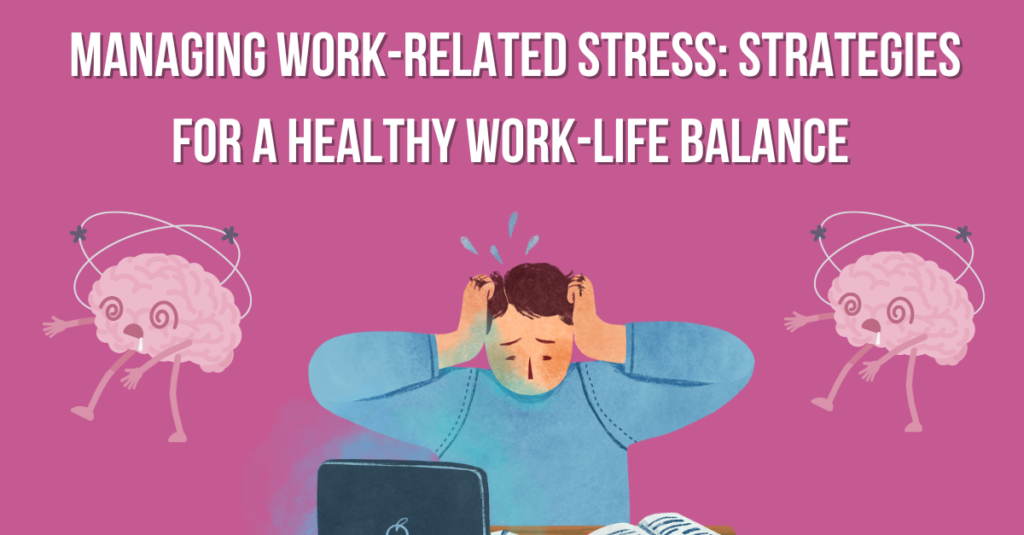Managing Work-Related Stress: Strategies for a Healthy Work-Life Balance
Introduction
In the hustle and bustle of today’s professional landscape, managing work-related stress has become essential for both individual well-being and organizational success. The prevalence of stress in the workplace can lead to a myriad of negative consequences, including diminished productivity, increased absenteeism, and adverse effects on mental and physical health. This article explores effective strategies for achieving a healthy work-life balance, offering insights into understanding and mitigating work-related stress.
By examining common stressors, recognizing signs, and implementing practical solutions, individuals and organizations can foster a more supportive and sustainable work environment. Join us on a journey to explore key techniques and initiatives that empower individuals to manage stress and cultivate a harmonious work-life balance.
Managing Work-Related Stress: Strategies for a Healthy Work-Life Balance
I. Understanding Work-Related Stress

A. Common Causes of Work-Related Stress
- High Workload and Tight Deadlines: The perpetual pressure to meet deadlines and manage heavy workloads is a primary contributor to work-related stress. The constant feeling of being overwhelmed can lead to burnout and adversely affect an individual’s mental and physical health.
- Lack of Control and Autonomy: Employees who feel micromanaged or lack control over their work may experience heightened stress levels. Autonomy in decision-making and task execution is crucial for fostering a sense of ownership and reducing stress.
- Poor Work-Life Balance: Striking a balance between professional and personal life is often challenging in a culture that glorifies busyness. Long working hours and the inability to disconnect from work during personal time contribute significantly to work-related stress.
- Unclear Job Expectations and Roles: Ambiguity in job roles and expectations can create confusion and stress. Employees need clear guidance on their responsibilities to perform effectively and feel confident in their roles.
B. Recognizing the Signs and Symptoms of Work-Related Stress
- Physical Symptoms: Work-related stress can manifest physically, leading to headaches, muscle tension, fatigue, and sleep disturbances. Recognizing these symptoms early is crucial for taking preventive action.
- Emotional Symptoms: Stress often takes a toll on emotional well-being, leading to feelings of anxiety, irritability, and even depression. Emotional intelligence and self-awareness are essential for managing and mitigating these emotional stressors.
- Behavioral Symptoms: Changes in behavior, such as increased absenteeism, decreased productivity, or strained relationships with colleagues, may indicate work-related stress. Identifying these behavioral shifts allows for early intervention and support.
II. The Importance of Work-Life Balance
A. Definition of Work-Life Balance
Work-life balance is the equilibrium between professional obligations and personal pursuits, encompassing various aspects such as time, energy, and attention. Achieving work-life balance is not only essential for individual well-being but also pivotal for sustained organizational success.
B. The Benefits of a Healthy Work-Life Balance
- Improved Mental and Physical Health: A well-balanced work-life routine contributes to better mental health, reducing the risk of stress-related illnesses. Physical well-being is also enhanced through regular exercise, adequate sleep, and stress management practices.
- Increased Productivity and Job Satisfaction: Employees with a healthy work-life balance are more likely to be productive and satisfied in their roles. Taking time for personal interests and relationships rejuvenates individuals, positively impacting their professional performance.
- Better Relationships and Overall Well-Being: Balancing work and personal life fosters stronger relationships with family and friends, enhancing overall life satisfaction. This, in turn, creates a positive feedback loop, improving mental resilience and the ability to cope with workplace stressors.
III. Strategies for Managing Work-Related Stress

A. Time Management Techniques
- Prioritization of Tasks: Creating a hierarchy of tasks based on urgency and importance helps individuals focus on what truly matters, preventing feelings of overwhelm.
- Setting Realistic Goals and Deadlines: Establishing achievable goals and deadlines promotes a sense of accomplishment, reducing stress associated with unrealistic expectations.
- Effective Delegation: Delegating tasks appropriately distributes the workload, empowering team members and preventing burnout.
B. Establishing Boundaries
- Setting Limits on Working Hours: Defining clear boundaries for working hours helps prevent overworking and allows individuals to recharge during personal time.
- Learning to Say No: Setting realistic expectations and declining additional responsibilities when necessary is crucial for maintaining a healthy work-life balance.
- Creating a Designated Workspace: Separating professional and personal spaces, even in a remote work setting, helps create a mental boundary between work and leisure.
C. Self-Care Practices
- Regular Exercise: Physical activity is a proven stress-reliever, releasing endorphins that contribute to improved mood and overall well-being.
- Adequate Sleep: Prioritizing sufficient sleep is fundamental to cognitive function, emotional resilience, and overall health.
- Mindfulness and Meditation: Incorporating mindfulness practices into daily routines can help manage stress by promoting relaxation and mental clarity.
D. Seeking Social Support
- Building Positive Relationships at Work: Cultivating positive relationships with colleagues fosters a supportive work environment, providing a buffer against stress.
- Connecting with Friends and Family Outside of Work: Maintaining a strong support network outside of the workplace is essential for emotional well-being and stress management.
- Seeking Professional Help When Needed: Recognizing the need for professional support, such as counseling or therapy, is a crucial step in managing chronic or severe stress.
IV. Implementing Work-Related Stress Reduction Programs in the Workplace

A. Employer’s Role in Managing Stress
- Creating a Supportive Work Environment: Employers play a pivotal role in fostering a workplace culture that values employee well-being, providing resources and support systems.
- Providing Resources for Stress Management: Offering workshops, training sessions, and access to mental health resources demonstrates an organization’s commitment to supporting employees’ mental and emotional health.
- Encouraging Open Communication: Establishing channels for open communication allows employees to express concerns, share feedback, and collaborate on solutions to mitigate workplace stressors.
B. Employee Engagement in Stress Reduction Programs
- Participating in Wellness Initiatives: Actively engaging in workplace wellness programs, such as fitness challenges or mindfulness workshops, promotes a holistic approach to stress management.
- Utilizing Available Resources: Employees should be encouraged to make use of available resources, such as counseling services, employee assistance programs, and flexible work arrangements.
- Providing Feedback on Workplace Stressors: Creating a feedback loop allows employees to communicate specific stressors and contribute to ongoing efforts to enhance the work environment.
V. Case Studies: Successful Implementation of Stress Management Strategies
A. Examples of Companies with Effective Stress Management Programs
- Google: Known for its employee-friendly policies, Google offers a range of wellness programs, including fitness classes, mental health support, and mindfulness training.
- Salesforce: Salesforce prioritizes employee well-being through initiatives such as wellness reimbursements, flexible work arrangements, and mindfulness programs.
B. Highlighting Positive Outcomes for Individuals and Organizations
- Increased Employee Retention: Organizations that prioritize stress management often experience higher employee retention rates, reducing recruitment and training costs.
- Enhanced Productivity: Employees who effectively manage stress are more focused, creative, and productive, contributing to overall organizational success.
- Positive Workplace Culture: A workplace that values work-life balance and stress reduction fosters a positive culture, attracting top talent and promoting a collaborative environment.
Conclusion (Managing Work-Related Stress: Strategies for a Healthy Work-Life Balance)

My name is Rohit Vagh and I’m a content writer specializing in fashion and lifestyle. I have three years of experience in this field and have written various articles. My writing style is creative and engaging, and I strive to create content that resonates with my readers. I have a deep passion for fashion and am constantly researching the latest trends and styles to make sure my readers are up to date. I’m excited to continue my career in blogging, and I’m always looking for new opportunities in the fashion and lifestyle space.




